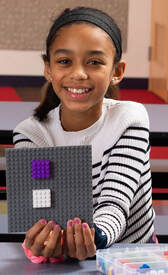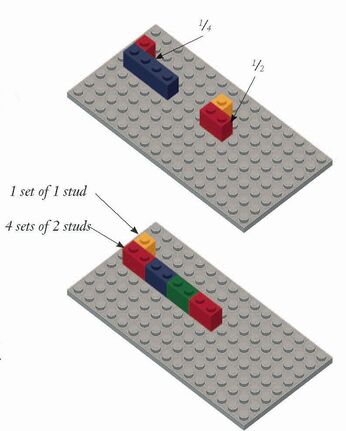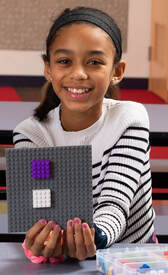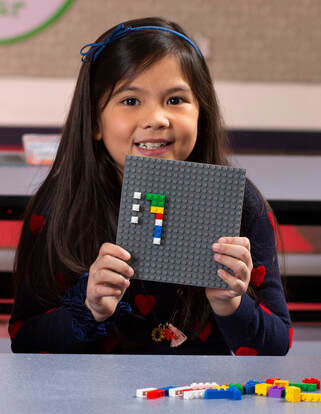 This month's free Brick Math Lesson of the Month is a game for students to play that reinforces multiplication terminology and skills. You can get the Blocks and Bricks Game, from Brick Math Multiplication, by clicking here, and you'll get a new free Brick Math lesson every month after that.  The Blocks and Bricks Game is played in pairs. Each student rolls a die twice, first to establish their multiplier and then their multiplicand. They then build blocks representing the multiplier and fill them with bricks representing the multiplicand. The directions for the game are given for the teacher to explain in the Teacher Lesson Plans and then given to the student in the Student Workbook Pages.  The Blocks and Bricks Game is a fun, non-competitive way for students to practice simple multiplication facts and their knowledge of multiplication vocabulary. It's a great summer activity to keep students enjoying math! Brick Math is a complete math curriculum for kindergarten through 8th grade that models the math with bricks. The curriculum is divided into 13 separate content areas: Counting, Addition, Subtraction, Multiplication, Division, Basic Fractions, Basic Measurement, Fraction Multiplication, Fraction Division, Advanced Measurement and Geometry, Decimals, Data and Statistics, and Pre-Algebra. Students can start anywhere in the curriculum. It can be used as a complete math curriculum or brought in as a supplement to help students who aren't having math success with other programs.  Brick Math works in many applications: for homeschooling, math intervention, enrichment, and as a whole-school program. Materials are simple and affordable. If you are a math teacher or a parent with a student at home who is learning K-8th grade math, check brickmath.com. The website includes videos for both teacher training and direct instruction of students. You can learn more about how Brick Math improves students' math test scores and hear what people who are using Brick Math have to say about the program.
0 Comments
 The July 2023 Brick Math Lesson of the Month comes from Multiplication Using LEGO® Bricks, one of the best-selling titles in the Brick Math Series. The lesson teaches students about arrays, and shows how to model multiplication with bricks that create arrays. It's a great way to reinforce multiplication while adding the new vocabulary of arrays and area. To get the July 2023 Brick Math Lesson of the Month, "Multiplication with Array Models," plus a new lesson each month, click here. Each Lesson of the Month includes the Teacher Lesson Guide as well as the Student Workbook pages that correspond to the lesson.  In this lesson, students learn about arrays and the importance of knowing the orientation of an array. Then they learn to build multiplication sentences based on the array's configuration. These exercises really help students understand the concepts behind one-digit multiplication.  Bricks are the perfect tools to model arrays. Modeling with bricks helps students understand what an array is and how it relates to multiplication. The study of mathematics is a building process (pun intended!) that relies on students understanding foundational math before moving on to more complex ideas.  Brick Math is a K-6 math curriculum that uses LEGO® bricks to model 11 different math subjects: Counting, Addition, Subtraction, Multiplication, Division, Basic Fractions, Basic Measurement, Fraction Multiplication, Fraction Division, Advanced Measurement and Geometry, and Decimals. This year, the program will expand to include grades 6 - 8, with the additional subjects Data and Statistics, Pre-Algebra, and Ratios and Proportions. Brick Math works in many applications: for homeschooling, math intervention, enrichment, and as a whole-school program. Materials are simple and affordable. If you are a math teacher or a parent with a student at home who is learning K-8th grade math, check brickmath.com. The website includes videos for both teacher training and direct instruction of students. You can learn more about how Brick Math improves students' math test scores and hear what people who are using Brick Math have to say about the program.
 February's Lesson of the Month is on multiplying unit fractions by fractions. Unit fractions are those that have a 1 in the numerator. This lesson shows how to model the multiplication of any unit fraction by any other fraction. It's key to understanding what it actually means to multiply fractions together. The lesson is from Brick Math's Fraction Multiplication Using LEGO® Bricks. To get the February 2023 Brick Math Lesson of the Month, "Multiplying Unit Fractions by Fractions," plus a new lesson each month, click here.  The lesson starts with a discussion of the term unit fraction, along with a discussion about how to determine which unit fraction is largest: 1/2, 1/3, or 1/4. The lesson then moves on to modeling two multiplication problems. Most 4th - 6th grade math teachers would agree that multiplying and dividing fractions is a very tricky subject for students to understand. The methods in Brick Math help make clear to students what is actually happening when two fractions are multiplied together -- not simply the process of multiplying the numerators and denominators together. This kind of deep understanding gives students a strong foundation in math that they can build on as they progress into middle school math and beyond. Brick Math is a K-6 math curriculum that uses LEGO® bricks to model 11 different math subjects: Counting, Addition, Subtraction, Multiplication, Division, Basic Fractions, Basic Measurement, Fraction Multiplication, Fraction Division, Advanced Measurement and Geometry, and Decimals. This year, the program will expand to include grades 6 - 8, with the additional subjects Data and Statistics, Pre-Algebra, and Ratios and Proportions. Brick Math works in many applications: for homeschooling, math intervention, enrichment, and as a whole-school program. Materials are simple and affordable.
If you are a math teacher or a parent with a student at home who is learning K - 6th grade math, check brickmath.com. The website includes videos for both teacher training and direct instruction of students. You can learn more about how Brick Math improves students' math test scores and hear what people who are using Brick Math have to say about the program.  This month's free Brick Math Lesson of the Month is simple but powerful. It demonstrates the idea of fact families and shows students how to model them using LEGO® bricks so they can fully grasp the concept. This lesson, "Fact Families," from Multiplication Using LEGO® Bricks, includes pages from the Teacher and Student books, along with a video demonstrating the lesson. To get the June 2021 Lesson of the Month and a link to the video lesson, plus a new lesson each month, click here.  Knowing fact families is a big step toward learning multiplication facts. In this lesson, students are asked to model the fact families for the numbers 6 and 8 using bricks. The lesson also gives teachers a very clear way to demonstrate the meaning of "4 sets of 2" (4 x 2) versus "2 sets of 4" (2 x 4). Besides showing the commutative property of multiplication, the concept of sets is important in many applications , including engineering, as well as a simple application such as sharing!  This lesson is from Chapter 3 of Multiplication Using LEGO® Bricks in the Brick Math series. Students typically learn this skill in grades 2-3. Try the free lesson with your students to see how much fun it is to learn with Brick Math! Brick Math is a K-6 math curriculum that uses LEGO® bricks to model 11 different math subjects: Counting, Addition, Subtraction, Multiplication, Division, Basic Fractions, Basic Measurement, Fraction Multiplication, Fraction Division, Advanced Measurement and Geometry, and Decimals. It works well for homeschooling, math intervention, enrichment, and as a whole-school program. Materials are simple and affordable. If you teach math or have a student at home who is learning math, check brickmath.com. The website includes videos for both teacher training and direct instruction of students. You can learn more about how Brick Math improves student math test scores and hear what people who are using Brick Math have to say about the program.  I recently had a customer tell me that her son didn’t understand the idea of factors until she tried Brick Math. When he saw the concept of factors made real with LEGO bricks, she said, he knew what they were! It’s exciting to hear when students finally “get it” because modeling with bricks makes all the difference for them. I started to think about that lesson on factors, and I realized it is the perfect way to demonstrate the power of Brick Math as a learning system. Here’s why Brick Math works so well to teach elementary math: it’s tactile (kids touch the bricks and build the models themselves), it’s visual (kids can see exactly what the numbers in a math problem represent), and it’s conceptual (kids understand the underlying idea behind the math when they discover it for themselves in a guided program). Let me show you how Brick Math works with that lesson on factors: This lesson models all the factors of 16 and demonstrates perfectly the meaning of “factor." Like all Brick Math lessons, it starts with some basic bricks and a baseplate to build on. Begin by placing one brick that has 16 studs on the baseplate (studs are the bumps on LEGO bricks). This can be a 2x8 brick or a 1x16 brick.The model shows 1 brick with 16 studs, so the multiplication fact shown is 1 x 16 = 16. 16 and 1 are factors of 16.  Next, take two bricks that each have 8 studs and place them next to the brick that’s already on the baseplate. It’s best if those two bricks are two different colors. You’ll use either two 2x4 bricks or two 1x8 bricks. Now the model shows 2 (bricks) x 8 (studs) = 16, and that 2 and 8 are also factors of 16. Now, here’s where the Brick Math program really becomes a powerful learning tool. For the next step, ask the student, “Are there 3 bricks that are all the same size that you can use to build the next row?” Let your students try with different bricks. They will demonstrate to themselves that there are none, so 3 can’t be a factor of 16. It’s so important that students discover for themselves while they are learning. That’s what helps them internalize what the math is all about. When they move on to looking for 4 bricks, they’ll find that four 2x2 bricks or 1x4 bricks do the trick. Now, they have 4 (bricks) x 4 (studs) = 16, so 4 is another factor of 16.  Have them look again for 5, 6, and 7 bricks that work in the model. They’ll quickly figure out that none of those numbers are factors of 16. They’ll move on to modeling eight 1x2 bricks, with the multiplication fact of 8 x 2 = 16. Finally, they can add sixteen 1x1 bricks to the model to complete all the factors with the multiplication fact of 16 x 1 = 16. When you look at the final model and count the number of bricks, the final model clearly shows the factors of 16: 1, 2, 4, 8, and 16. Dr. Shirley Disseler, developer of the Brick Math method, demonstrates this same lesson in the video below.  The concept of factors is key to learning multiplication, division, and fractions, so it’s in all three of the Brick Math books on those subjects: Multiplication, Division, and Basic Fractions. And it (almost) goes without saying: students have fun while they learn! If you teach math or have a student at home who is learning math, check brickmath.com. The website includes videos for both teacher training and direct instruction of students. You can learn more about how Brick Math improves student math test scores and hear what people who are using Brick Math have to say about the program.
Brick Math is a K-6 math curriculum that uses LEGO® bricks to model 11 different math subjects: Counting, Addition, Subtraction, Multiplication, Division, Basic Fractions, Basic Measurement, Fraction Multiplication, Fraction Division, Advanced Measurement and Geometry, and Decimals. It works well for math intervention, for enrichment, and as a whole-school program. Materials are simple and need not be shared between students. It adapts easily to online instruction. Contact us with any questions.  Whether you're back to school in person or online, or some combination of the two, this free Brick Math Lesson of the Month is a great way to help students learn math. For September, it's a lesson from Fraction Multiplication Using LEGO® Bricks that shows how the commutative property works when multiplying fractions. Students typically learn about multiplying fractions in grades 4 - 6, but it is sometimes part of the curriculum when students are learning about fractions in grades 2 - 3. To get the free Lesson of the Month for September 2020, click here. Students should already understand that a x b = b x a (see Multiplication Using LEGO® Bricks, chapter 5). Now it's time for them to learn that the same commutative property holds when multiplying fractions. This lesson makes it clear to students by using bricks one way to model 1/2 x 6, and a different way to model 6 x 1/2. In both cases, the answer, 3, is the same.  This lesson also shows how the two number sentences are used to describe different real-life situations: 1/2 x 6 means "one-half of six," while 6 x 1/2 means "six sets of one-half." So in real-life usage, 1/2 x 6 could describe "half of the six crayons in the box, or three crayons." And 6 x 1/2 could describe "six half-pizzas, or three whole pizzas." Using bricks to model these two scenarios really helps students understand the math.  Brick Math is a K-6 math curriculum that uses LEGO® bricks to model 11 different math subjects: Counting, Addition, Subtraction, Multiplication, Division, Basic Fractions, Basic Measurement, Fraction Multiplication, Fraction Division, Advanced Measurement and Geometry, and Decimals. It works well for math intervention, for enrichment, and as a whole-school program. Materials are simple and are not shared between students. It adapts easily to online instruction. If you teach math or have a student at home who is learning math, check brickmath.com. The website includes videos for both teacher training and direct instruction of students. You can learn more about how Brick Math improves student math test scores and hear what people who are using Brick Math have to say about the program.  April's Brick Math Lesson of the Month is about Multiplication. It's a great way to show students exactly what multiplication means, using a bundling technique with bricks. There are two math problems in this lesson of the month to show how the bundling technique works: first, 2 x 25, and second, 3 x 12. In both problems, the math is modeled to show the sets. The problems also show the difference in modeling if the numbers are reversed; i.e., 25 x 2 or 12 x 3. This Lesson of the Month shows 4 pages from the Multiplication Teacher Edition first, and then the corresponding pages for students to use from the companion Multiplication Student Edition. Sign up here to receive a FREE Brick Math Lesson of the Month every month!  Learning multiplication is NOT memorizing times tables! The rote process of repeating multiplication tables over and over, taking speed tests, and writing math facts ten times each— these instructional methods are not supported in educational research. Students learn the concept of multiplication best through the process of modeling with manipulatives. And that’s where Brick Math can help students learn multiplication. The Brick Math program uses LEGO® or LEGO®-compatible bricks as the manipulatives. With Brick Math, students create models that help them understand the concepts behind multiplication. Students begin with the basics—understanding the meaning of multiplication as it relates to repeated addition. This understanding usually begins in grade 2 with the introduction of sets and its relationship to skip-counting. Students then learn basic facts of multiplication through modeling, arrays, and word problems, typically in grade 3. They work on one-digit multiplication problems and later learn how to multiply two-digit numbers and beyond in grades 4 and 5. In Brick Math, students learn multiplication through an integrated program. They create models using the bricks. They then draw the models they’ve created. Finally, they explain in writing how and why they created the models. These three different ways of interacting with bricks lead to a deep understanding of how multiplication works. When students model the action of multiplication using bricks, they have the opportunity to create multiple solutions to problems instead of looking for the one right answer. Watch the video below to see a Brick Math lesson in action. This one is about multiplication fact families. Then click here to download a lesson plan about finding factors from the Brick Math book Multiplication Using LEGO® Bricks—Teacher Edition. Brick Math is fun! Students love playing with bricks, and Brick Math helps them discover that math can be entertaining. As one Brick Math student said: “Why doesn’t everyone learn math this way?”  Pat Hensley of the blog Successful Teaching just reviewed one of the Brick Math books, Teaching Multiplication Using LEGO Bricks. Glad to say that Pat loved it! Read her whole review here: https://successfulteaching.blogspot.com/2017/08/teaching-multiplication-using-lego.html Pat found the lessons easy to follow and great for classroom teachers or a homeschool situation. We're supplying a free book for one lucky reader of Successful Teaching, so go to Pat's blog and sign up to win the book before September 4!  Multiplication is not simply the rote memorization of times tables. Students need to understand multiplication concepts. LEGO® bricks are the perfect manipulative to help students model, utilizing their creative and logical processes together. In this book, the hands-on activities using LEGO® bricks help students learn:
|
Categories
All
Archives
July 2024
|




